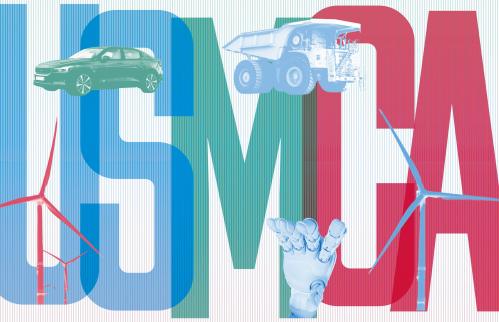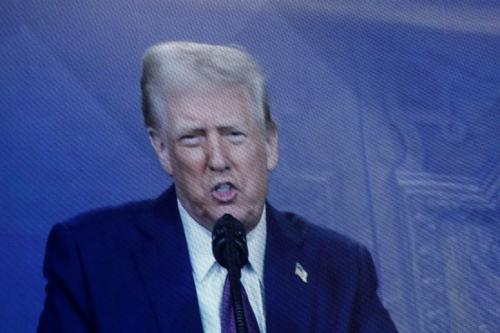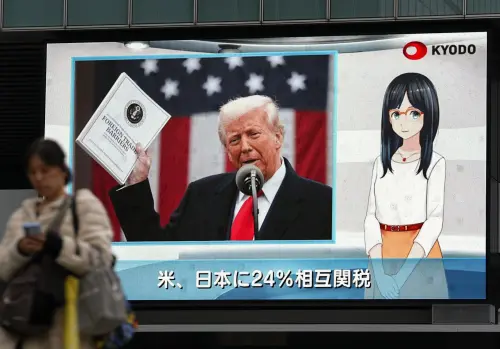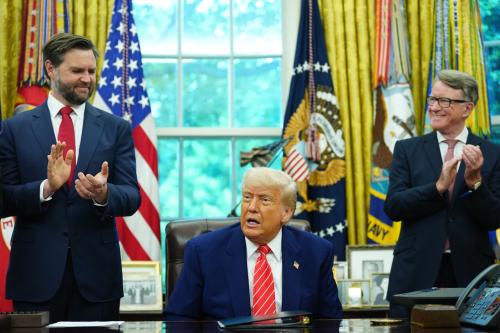Overview
Since coming into office, President Donald Trump increased U.S. tariffs on all imports from China to 145% (only to agree with China to 115% tariff reduction for 90 days on the most recent tariffs)1 and applied a global 10% tariff to the rest of the world and a global 25% tariff on imports of autos and steel and aluminum. Additional so-called reciprocal tariffs on the rest of the world except Canada and Mexico were announced on April 2 and then subsequently paused for 90 days. When it comes to Canada and Mexico, Trump imposed a 25% tariff on all imports from Canada and Mexico that do not comply with the United States-Mexico-Canada Agreement (USMCA) and applied a 25% tariff on autos imported under USMCA, but only on the non-U.S. content. Significantly, Trump did not impose additional so-called reciprocal tariffs on Canada and Mexico. As a result, the majority of U.S. imports from Canada and Mexico that are USMCA compliant continue to enter the U.S. duty free.
This mix of relatively higher China tariffs compared to tariffs on many of the U.S. imports from Canada and Mexico will have various implications for trade and investment across North America. For one, higher U.S. tariffs on China will also create a stronger incentive for China to circumvent U.S. tariffs by entering the U.S. via Mexico and Canada, and this incentive may extend to other countries that also face higher U.S. tariffs. The following outlines how Trump’s recent tariffs will affect trade and investment across North America with a particular focus on autos, and the implications for the 2026 review of the USMCA.
A snapshot of US tariffs
Table 1 lists tariffs on U.S. imports from Canada and Mexico, and the rest of the world. Following the 90-day pause in U.S. tariffs of 145% on all imports from China, China now faces tariffs ranging from 47.5% for autos, 50% on steel and aluminum, and 30% tariffs on all other imports. The U.S. has also applied a 25% tariff on all imports of autos and steel and aluminum. When it comes to U.S. auto imports from Canada and Mexico that are USMCA compliant, there is a 25% tariff. The rest of U.S. imports from Canada and Mexico that are consistent with USMCA enter the U.S. duty free, covering around 50% of Mexico’s exports to the U.S. and 40% of Canada’s exports to the U.S. In addition, on April 2, Trump announced reciprocal tariffs on the rest of the world (but not Canada and Mexico) ranging from 46% on imports from Vietnam, 36% on imports from Thailand, and 20% on imports from the EU, though these tariffs have been paused for 90 days to give countries time to strike a trade deal with the United States. Trump has also applied a 10% global tariff.
|
Country |
Autos | Steel and Aluminum | Other Imports |
| Canada | 25% on non-U.S. content (52.5% non-USMCA compliant) |
25% on steel/aluminum (excludes derivative articles melted and poured/cast and smelted in the U.S.) †Non-USMCA compliant imports: 50%
|
25% on non-USMCA goods; 10% on energy and potash |
| Mexico | 25% on non-U.S. content (52.5% non-USMCA compliant) |
25% on steel/aluminum (excludes derivative articles melted and poured/cast and smelted in the U.S.) †Non-USMCA compliant imports: 50% |
25% on non-USMCA goods |
| China | 47.5% | 50% | 30% on all other goods |
|
Rest of World (ex. Canada and Mexico) |
25%* |
25% |
10% tariff on imports from all countries except Canada and Mexico
|
* Under the U.S.-U.K. trade deal the U.S. auto tariff on U.K. imports will be replaced by an annual tariff rate quote of 10% for the first 100,000 auto imports, and then 25% for any additional imports https://www.whitehouse.gov/fact-sheets/2025/05/fact-sheet-u-s-uk-reach-historic-trade-deal/
New tariffs are also likely. The Department of Commerce has six national security-focused Section 232 reviews on copper, semiconductors, lumber, pharmaceuticals, critical minerals, and trucks, all of which could lead to additional tariffs on these products. A 25% tariff on non-U.S. content on auto part imports from Canada and Mexico is also planned.
Retaliation by other countries against U.S. tariffs has, except in the case of China, been restrained so far. China applied 125% tariffs on imports from the U.S., (that have been paused for 90 days), banned exports of various rare earths and critical minerals, added 29 U.S. companies to their entities list, and stopped orders of Boeing airplanes. Canada retaliated with a 25% tariff on non-USMCA compliant autos and a 25% tariff on $21 billion worth of steel and aluminum imports. Further retaliation from other countries is also likely should U.S. tariffs remain. For instance, Mexico, the EU, and Brazil have announced a list of retaliatory tariffs on U.S. imports, and Canada is likely to retaliate further in the event that the U.S., Canada, and Mexico are unable to reach a deal.2
The impact of US tariffs on North American trade, investment, and auto manufacturing
By July 2026, all three governments must review the USMCA and agree to extend the agreement for another 16-year term. Should an agreement not be reached, the three governments have until 2036 to reach an agreement, and failure to do so will lead to the expiration of the USMCA. The agreement’s review will be an opportunity to assess the USMCA’s operation, and it will also be an opportunity to update the agreement. For the U.S., the goal will be to update the agreement in part to force more manufacturing back into the U.S. The following outlines the key implications of current U.S. tariffs for trade and investment in North America. The next part analyzes what these developments might mean for the 2026 USMCA review.
More trade within North America will be channeled through USMCA as costs of non-compliance with USMCA increase. Under USMCA, the U.S., Canada, and Mexico agreed to reduce tariffs to zero. Trade between the three countries can also happen outside of the agreement, but in that case, imports are subject to the tariff rate the U.S. applies to all other World Trade Organization (WTO) member countries—the so-called WTO most-favored-nation (MFN) rate. As a general matter, the higher the WTO MFN rate, the greater the incentive for traders in Canada and Mexico to comply with USCMA to enter the U.S. duty free. For a product to comply with USMCA requires meeting the agreement’s rules of origin (ROOs). USMCA ROOs prevent traders in countries not party to the agreement from accessing the duty-free tariff rate by merely transshipping goods through Canada, Mexico, or the U.S. to reach another USMCA country. USMCA ROOs generally require some amount of manufacturing or processing to take place in either Canada, Mexico, or the U.S. to benefit from the zero USMCA tariff.
Until recently, the U.S. WTO MFN rate applied to auto imports was 2.5%. The effect of this was that as the costs of complying with the USMCA ROOs increased, companies increasingly decided to pay the 2.5% tariff instead of meeting the USMCA ROOs. During the negotiation of USMCA (which replaced NAFTA), the U.S. insisted on tighter ROOs aimed at forcing more auto manufacturing back into the U.S. For instance, USMCA increased the Regional Value Content (RVC) for cars and light trucks from 62.5% to 75%—the amount of North American content that must be used to manufacture a car. USMCA also eliminated the so-called deeming rule that had allowed auto parts not on a list created when NAFTA was negotiated to be “deemed” as originating in North America for the purposes of the RVC calculation. USMCA also introduced new requirements that 70% of the steel and aluminum in cars be sourced in North America, and that 40% of the Labor Value Content (LVC) used to produce a car must have a wage of at least $16 per hour.
The costs of complying with these tighter USMCA ROOs led to increasing car imports into the U.S. from Canada and Mexico that were not complying with USMCA and instead entered the U.S. by paying the WTO MFN 2.5% tariff. Indeed, since 2020, the share of vehicles imported into the U.S., which paid the 2.5% duty, went from 0.5% in 2019 (pre-USMCA) to 8.2% in 2023.3
The new 25% U.S. tariff on autos is in part a response to this trend by auto companies to pay the WTO MFN tariff instead of complying with USMCA ROOs. The higher auto tariff should lead to higher levels of compliance with USMCA ROOs, and by extension more auto manufacturing in North America. The new 25% tariff on the non-U.S. content on imports from Canada and Mexico will further push more automotive manufacturing back into the U.S. at the expense of Canada and Mexico. The recent announcement by Honda that it would manufacture its next-generation Civic hybrid model in the U.S. instead of in Mexico is an example of this trend.4
The overall impact of higher tariffs on auto manufacturing in the U.S. is unclear, with potential to be net negative. Higher U.S. tariffs create an incentive for car manufacturers to avoid the tariff by manufacturing more in the U.S. When it comes to Canada and Mexico, the new auto tariff on non-U.S. content is inconsistent with existing USMCA ROOs, which instead counts production within North America as counting toward the RVC requirement.
However, this tariff could also have various negative impacts on auto manufacturing in the U.S. For one, tariffs will increase the cost of manufacturing automobiles in the U.S., which could lead to less innovation, more costly cars, and lower sales.5 No other auto manufacturing region in the world has ROOs as restrictive as those under USMCA.
The auto tariff could also lead to retaliation by other countries, which could globally segment the auto market and result in less auto manufacturing in the U.S. for export.6 As noted, China had imposed tariffs of 125% on all U.S. exports. In 2024, the U.S. exported $4.93 billion of autos to China, which was the U.S.’ third largest market. EU retaliation on U.S. autos is also likely should U.S. auto tariffs on EU imports persist. The EU is the U.S.’ second largest auto market worth $12.4 billion in 2024. EU tariffs on auto imports from the U.S. could lead to EU auto manufacturers, such as BMW and Mercedes that currently manufacture in the U.S. for export to Europe (and globally), to relocate some manufacturing back to Europe. For example, the BMW plant in Spartanburg, South Carolina manufacturers SUVs for sale to Europe, employs 11,000 people, and in 2023 was the largest auto exporter from the U.S. by value.7
The current U.S. tariffs could increase investment in Canada and Mexico as a base for export. Proposed U.S. “reciprocal” tariffs on imports from a range of other countries—combined with continuing zero tariffs applied to USMCA consistent trade—will likely lead to even more investment in Canada and Mexico. As countries face higher U.S. tariffs, they will likely invest more in Canada and Mexico to produce goods for export to the U.S.
Canada and Mexico could also see increased investment by companies as a base for export globally. The extent to which this happens will depend on whether countries retaliate and raise tariffs on U.S. exports. When this happens it will create an incentive to export from Canada and Mexico to avoid tariffs that would apply when exporting from the U.S. Existing trade agreements between Canada, Mexico, and third countries also provides trade policy certainty and makes it unlikely that Canada and Mexico will face new tariffs. Canada currently has 15 free trade agreements, including with the United Kingdom, the EU, and countries within the Comprehensive and Progressive Agreement for Trans-Pacific Partnership. Mexico has 13 trade agreements, including with the EU, Japan, and members of the Central America-Mexico Free Trade Agreement.
The increase in U.S. tariffs on China increases the incentive for circumvention by China, and possibly other countries as well. Since the U.S. raised China tariffs in 2018, China was incentivized to circumvent these tariffs by entering the U.S. market via Mexico and Canada.8 This incentive is likely to grow as the U.S. expands and increases tariffs on imports from China. As noted, if the U.S. also implements “reciprocal” tariffs on other countries, this will create added incentives for these countries to also circumvent these tariffs by producing in Canada and Mexico for export to the U.S.
Implications of tariffs for USMCA review
These developments in U.S. tariffs will have various implications for the upcoming USMCA review. The fact that Canada and Mexico were exempt from the April 2 reciprocal tariffs suggests that Trump is not looking to pull out of the USMCA, and that existing tariffs on Canada and Mexico may ultimately be used as leverage during the upcoming USMCA review. The following does not attempt to address all the issues that will come up during the USMCA review and instead focuses on what these new U.S. tariffs might mean for the USMCA review—with a focus on autos—and how to address the incentives these tariffs create to circumvent them via Canada and Mexico. Getting to a new deal on autos will be critical for a successful USMCA review. Auto trade within North America comprises 17% of total trade across North America and is a major industry in all three countries that employs 13 million people.
A deal on autos will be central to any USMCA review. As noted, the impact of the current U.S. tariffs on U.S. auto manufacturing is unclear and could be net negative, depending on the extent to which other countries retaliate. The current U.S. tariffs on non-U.S. auto content on imports from Canada and Mexico are inconsistent with the United States’ current USMCA commitments, and if allowed to stand, could lead to more automotive manufacturing in the U.S. at the expense of Canada and Mexico. For this reason, a key objective for Canada and Mexico will be for the U.S. to calculate content from the U.S., Canada, and Mexico as counting toward USMCA ROOs. Progress on this issue will also matter for automakers that have built manufacturing supply chains across North America. Failure to reduce tariffs on auto imports within North America will also harm all three countries. Economic modeling of a U.S. 25% tariff on auto imports from Canada and Mexico finds that U.S. exports of automobiles to Canada and Mexico would contract by 25% and 23%, respectively. In the event that Canada and Mexico retaliate, U.S. automotive exports to Canada and Mexico would shrink by up to 55% and 65%, respectively.9
Given the stakes of getting to a deal on autos, the following assumes that the U.S. agrees to continue to count North America content toward USMCA auto ROOS. In parallel, it is also assumed that the U.S. will continue to apply a higher tariff on all non-USMCA compliant autos. Without the former, a deal on autos is unlikely. Higher tariffs on non-USMCA compliant auto imports will, however, be needed if the U.S. is to meet its goal of increasing auto manufacturing. With this as background, there are three potential pathways toward a new USMCA outcome on autos:
- No change to USMCA auto ROOs.
- No change to the USMCA ROOs as written, but Canada and Mexico agree to an interpretation of these ROOS that the U.S. has been pushing, which would have the effect of requiring more auto manufacturing in North America.
- Amend USMCA ROOs to be even more restrictive.
The following outlines these options in more detail.
No change to USMCA ROOs. The argument for this outcome is that it is too early to assess the impact of existing ROOs on auto manufacturing. One reason is that USMCA auto ROOs have not come fully into effect. For example, 13 companies were given until 2025 to gradually meet the RVC and LVC standards. Notwithstanding this, 2023 analysis by the U.S. International Trade Commission found that the new USMCA ROOs had already led to higher profits, wages, and manufacturing in U.S. autos.10 Companies have also reported challenges meeting existing auto ROOs, particularly in the context of the transition to electric vehicles (EVs) where many of the critical minerals needed to produce batteries are not domestically produced in the U.S.11 Given all of this, sustaining the current UMSCA ROOs with agreement to revisit may be the most prudent approach.12
Adopting the U.S. interpretation of USMCA ROOs. The three governments could tighten existing USMCA ROOs by agreeing to accept the U.S. interpretation of their operation (an interpretation that was struck down by a USMCA panel). Under the U.S. approach, non-USMCA content in “core parts”—engine, transmission, chassis, axle, suspension, steering, advanced batteries—would not count toward the overall RVC of a car. Adopting this approach (perhaps with agreement to phase in over time), would prevent auto companies from counting non-USMCA content in core parts toward overall USMCA RVC requirements. The net result being that more North American content would be needed to meet the RVC requirements.
Adopting new and stricter USMCA ROOs. It is also possible that the three governments agree even tighter USMCA ROOs. In this case, a staged approach seems critical given challenges complying with existing ROOs. New ROOs for EVs also seem necessary given developments in technology and challenges in securing North American supplies of the critical minerals used in batteries.
The following addresses additional issues raised by these new tariffs for the USMCA review.
Aligning with U.S. tariffs on China will be important but challenging. Since Trump applied 20% tariffs on imports from China in his first term, there has been an incentive for China to circumvent these tariffs on Chinese products by entering the U.S. market via Mexico and Canada, taking advantage of USMCA zero tariffs where possible. Addressing Chinese circumvention has become an increased focus, and as outlined above, the new U.S. tariffs on China will increase the incentive for China to circumvent these tariffs via Mexico and Canada. Mexico and Canada understand this risk and have been moving to align with U.S. on China tariffs in some areas. For instance, in 2024, Canada applied a 100% tariff to EVs and 25% tariffs on steel and aluminum products from China, and Mexico agreed to require melting and pouring of steel and smelting and casting of aluminum to be restricted to North America. In April 2024, Mexico also increased its tariffs on countries with which it does not have a free trade agreement, including China, on products such as steel and aluminum and some auto parts. The bottom line is that closer alignment between Mexico and Canada with U.S. China tariffs has begun, but more will be needed to address the incentives for circumvention. Yet, the recent expansion and increase in U.S. tariffs on imports from China will make alignment difficult, given that Chinese imports remain important inputs into a range of manufacturing sectors.
Another related issue is Chinese foreign investment into Mexico and Canada, which can be another means of circumventing U.S. tariffs. Trump’s executive order on investment policy signals further restrictions on Chinese investment into the U.S. across a range of critical industries.13 Canada is already well aligned with the U.S. foreign investment screening for China, but Mexico lags. In 2024, President Joe Biden and Mexican President Claudia Sheinbaum signed a memorandum of intent to establish a working group on investment screening and its role in national security. This progress will likely be an important part of the USMCA review.
Additional U.S. tariffs on other countries might also need to be addressed in the USMCA review. The proposed U.S. reciprocal tariffs on 58 countries (including the 27 EU members) have been paused. But new tariffs are likely, even in the event of successful deals with individual countries. U.S. tariffs on third countries will create a new incentive for these countries to enter the U.S. market via Mexico and Canada. However, getting Mexico and Canada to address circumvention by applying similar tariffs to these countries, or to screen out their foreign investment, will be resisted. Unilateral Mexican and Canadian tariffs against other countries would be in breach of their WTO commitments, and in many cases their free trade agreements with many of these countries. Mexico and Canada will also be reluctant to undermine trade relations with third countries at a time when Trump has sent a clear signal to Canada and Mexico of the imperative of reducing their trade exposure to the U.S., while necessitating more, not less, trade with other countries.
USMCA review will also need to resolve bilateral trade barriers. There are various bilateral trade barriers that are well known and should be largely resolvable during a good faith effort to update USMCA. The Office of the U.S. Trade Representative in its 2025 National Trade Estimate (NTE) Report listed the trade barriers of most concern for the United States. For Canada, this includes its supply-management system for dairy (that has also been subject to a USMCA dispute), various digital trade issues, and access to U.S. agricultural products. For Mexico, trade barriers include access to U.S. agricultural exports, including biotech corn, intellectual property (IP) protection, and various barriers to services and energy exports.14 For Canada and Mexico, Buy American provisions, including ones that prioritize U.S. businesses, have been another long-standing issue.15 Perhaps even more important for Canada and Mexico will be the United States’ commitment to minimizing the risk of new tariffs. While this will be seen by some in the Trump administration as inhibiting freedom of action, it is of self-interest to set realistic boundaries on future trade actions against Canada and Mexico in order to restore business confidence in North America.
Conclusion
USMCA is the most important trade agreement for the U.S., Canada, and Mexico. In a world of competition with China and high tariffs that point to further decoupling of the U.S. and Chinese economies, finding ways to strengthen opportunities for trade and investment within North America will be critical. A successful review of USMCA will be needed if the U.S. is to restore confidence in North America. Recent U.S. tariffs on Canada and Mexico are relatively targeted, but agreeing on autos will be critical if the USMCA review is to succeed. Moreover, these tariffs raise new challenges, including the impact of circumvention from China and potentially from other countries that are likely to face higher U.S. tariffs. Fortunately, there are various paths to reaching a successful USMCA review that can achieve the dual goal of both increasing manufacturing and successfully competing with China. The question is whether the U.S. is willing to take it.
-
Footnotes
- https://www.whitehouse.gov/articles/2025/05/art-of-the-deal-u-s-china-ink-initial-trade-deal/
- Brazil, Colombia, and Côte d’Ivoire have also announced potential retaliatory tariffs
- USTR, Report to Congress on the Operation of the United States-Mexico-Canada Agreement with Respect to Trade in Automotive Goods, July 1, 2024, p. 11.
- https://www.reuters.com/business/autos-transportation/honda-produce-next-civic-indiana-not-mexico-due-us-tariffs-sources-say-2025-03-03/.
- https://www.marketsandmarkets.com/Market-Reports/global-automotive-industry-outlook-77960341.html.
- https://www.ecoportal.net/en/german-carmaker-moves-to-america-will/1603/.
- https://www.carscoops.com/2024/09/trump-i-want-german-car-companies-to-become-american-car-companies/.
- Joshua Meltzer and Maricarmen Barron Esper, “China Circumvention of U.S. Tariffs” (Brookings Institution, forthcoming May 2025).
- Joshua P. Meltzer, “Trump’s 25% tariffs on Canada and Mexico will be a blow to all 3 economies”, Brookings Commentary, February 2025.
- USITC, USMCA Automotive Rules of Origin: Economic Impact and Operation, 2023 Report, June 2023.
- USTR, Report to Congress on the Operation of the United States-Mexico-Canada Agreement with Respect to Trade in Automotive Goods, July 1, 2024, USMCA Forward 2025.
- US ITC Auto ROOS.
- https://www.whitehouse.gov/presidential-actions/2025/02/america-first-investment-policy/.
- USTR National Trade Estimate Report, 2025 https://ustr.gov/sites/default/files/files/Press/Reports/2025NTE.pdf
- https://tradecouncil.org/wp-content/uploads/2024/10/Analyzing-the-Global-Impact-of-Americas-Buy-American-Policy.pdf.
The Brookings Institution is committed to quality, independence, and impact.
We are supported by a diverse array of funders. In line with our values and policies, each Brookings publication represents the sole views of its author(s).






